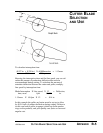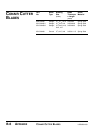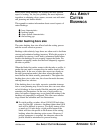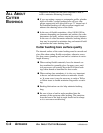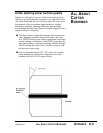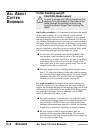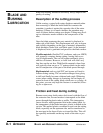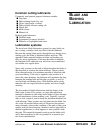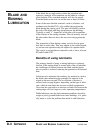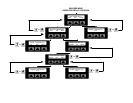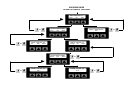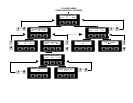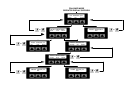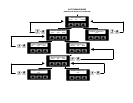
Common cutting lubricants
Commonly used general purpose lubricants include:
● Tap water
● Dish washing liquid (Joy, etc)
● Glycol (anti-freeze, coolant)
● Water-soluble silicone cutting oils
● Diesel fuel
● Mold release
● Mineral oil
Medical grade lubricants:
● Distilled water
● Isopropanol (isopropyl alcohol)
● Mixtures of isopropanol and water
BLADE AND
BUSHING
LUBRICATION
Lubrication systems
The most basic blade lubrication system for rotary knife cut-
ters is using a stainless steel tray filled with the lubricant.
Because the cutting blade passes through the tray during every
cutting cycle, the blade is lubricated before each cut. This
approach limits material buildup on blade and bushing sur-
faces for most applications. Care must be taken to maintain
the lubricant level within the tray and clean out accumulated
cut residue on a regular basis.
Spray mist systems can be used to lubricate either the blade or
the extrudate as it enters the cutter bushings. These systems
allow the application of a minimum amount of lubricant with
good consistency. If the mist is applied to the product as it
enters the cutter bushings, the lubricant will minimize the drag
between the bushing bore and the tube or profile, as well as
wet the blade and bushing faces. With flexible and/or sticky
materials this can improve both cut quality and cut-to-length
accuracy.
The last method of blade lubrication (and the oldest) is the
blade wipe system. Felt, sponge, or some other absorbent
material is mounted so the rotary knife blade will pass through
it, with interference, before making a cut. Typically a gravity
drip or wick system is used to keep the absorbent material wet
with lubricant. These systems not only lubricate the blade, but
also wipe off residue before each cut. However, the operator
must constantly observe the condition of the pads as they wear
quickly and lose their function. Another concern (especially in
medical applications) is what happens to wear particles from
the pads. This material frequently ends up on the blade itself,
and is then transferred to the very product it is meant to pro-
tect from contamination.
APPENDIX D-2
UGE059/1003 B
LADE AND BUSHING LUBRICATION



